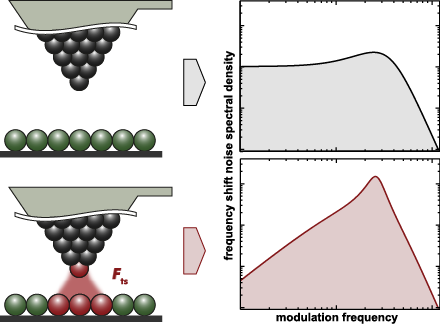Search results
Search for "frequency shift noise" in Full Text gives 4 result(s) in Beilstein Journal of Nanotechnology.
A cantilever-based, ultrahigh-vacuum, low-temperature scanning probe instrument for multidimensional scanning force microscopy
Beilstein J. Nanotechnol. 2022, 13, 1120–1140, doi:10.3762/bjnano.13.95

- islands on top (see section “Results and Discussion”). There is a third noise source, namely the oscillator noise given by Equation 3, which is, however, relevant only for low-quality factor conditions [59]. An experimental evaluation of the measured frequency shift noise revealed that it depends as on
Noise in NC-AFM measurements with significant tip–sample interaction
Beilstein J. Nanotechnol. 2016, 7, 1885–1904, doi:10.3762/bjnano.7.181

- & Astronomy, The University of Nottingham, University Park, Nottingham NG7 2RD, UK 10.3762/bjnano.7.181 Abstract The frequency shift noise in non-contact atomic force microscopy (NC-AFM) imaging and spectroscopy consists of thermal noise and detection system noise with an additional contribution from
- : amplitude noise; cantilever stiffness; closed loop; detection system noise; frequency shift noise; non-contact atomic force microscopy (NC-AFM); Q-factor; spectral analysis; thermal noise; tip–sample interaction; Introduction Non-contact atomic force microscopy (NC-AFM) [1][2] is an unmatched surface
- demodulator (mostly a phase-locked loop detector, PLL), cantilever properties and ultimately thermal noise [11]. The footing of our work are these precursor studies, and the rigorous system analysis introduced by Polesel-Maris et al. [12], showing that the frequency shift noise at close tip–sample distance is
Determining cantilever stiffness from thermal noise
Beilstein J. Nanotechnol. 2013, 4, 227–233, doi:10.3762/bjnano.4.23
- which the PLL transfer function is known. The former condition requires the detection system noise floor to be so low that, at least over a significant fraction of the PLL demodulator bandwidth, the frequency shift noise spectral density (fm) of the detection system is negligible compared to the
- thermal frequency-shift noise spectral density (fm) [6]. Results and Discussion Stiffness from displacement thermal noise In a displacement noise measurement of a cantilever with a high Q-factor, the spectrum analyser measures the total displacement noise spectral density (f) for the nth cantilever
- output or loop filter Gfilter, the frequency shift noise spectral density at the PLL output can be represented as [6] This allows us to obtain the modal stiffness from a measurement of if all other parameters are known: Practically, the spectral analysis can be restricted to the frequency range of 10 Hz
Thermal noise limit for ultra-high vacuum noncontact atomic force microscopy
Beilstein J. Nanotechnol. 2013, 4, 32–44, doi:10.3762/bjnano.4.4
- ) consists of cantilever thermal noise, tip–surface-interaction noise and instrumental noise from the detection and signal processing systems. We investigate how the displacement-noise spectral density dz at the input of the frequency demodulator propagates to the frequency-shift-noise spectral density dΔf
- of 100 Hz to 1 kHz. As the noise is transformed by the demodulator in a similar way, we define and as the frequency-shift-noise spectral density and the frequency-shift-noise power spectral density, respectively, and discuss separate noise contributions and to the frequency-shift signal Δf, as
- used in the detection system. In contrast to thermal noise, which is a fixed quantity for a given cantilever and temperature, the detection-system noise floor can be reduced by technical improvements of the detection system [3][7][8]. Frequency-shift noise The frequency demodulator of the NC-AFM system























![[Graphic 32]](/bjnano/content/inline/2190-4286-7-181-i73.png?max-width=637&scale=1.18182) wit...
wit...

![[Graphic 34]](/bjnano/content/inline/2190-4286-7-181-i75.png?max-width=637&scale=1.18182) wit...
wit...






![[Graphic 34]](/bjnano/content/inline/2190-4286-4-23-i40.png?max-width=637&scale=1.18182) measured for the fundamental mode of cantilever V 4. Measureme...
measured for the fundamental mode of cantilever V 4. Measureme...


![[Graphic 23]](/bjnano/content/inline/2190-4286-4-23-i29.png?max-width=637&scale=1.18182) measured for cantilever V 4 (A0 = 16.8 nm, demodulator band...
measured for cantilever V 4 (A0 = 16.8 nm, demodulator band...




![[Graphic 53]](/bjnano/content/inline/2190-4286-4-4-i64.png?max-width=637&scale=1.18182) =
= ![[Graphic 32]](/bjnano/content/inline/2190-4286-4-4-i43.png?max-width=637&scale=1.18182) f...
f...



![[Graphic 56]](/bjnano/content/inline/2190-4286-4-4-i67.png?max-width=637&scale=1.18182) using three diff...
using three diff...




